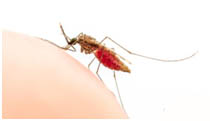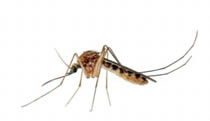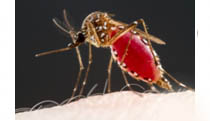Mosquitoes are the deadliest animal on the planet, responsible for over 1 million deaths per year worldwide. The mosquitoes are of great hygienic importance. They are capable of transmitting several potentially life-threatening diseases. They are small insects, with long legs, globular head, laterally compressed thorax and long cylindrical abdomen. The antennae are hairy in the female and bushy in the male. There are about 3000 species of mosquitoes, of which 100 are vectors of human diseases, and feed on human and animal blood. Most species show preferences for certain animals or humans. They are attracted by body odors, carbon dioxide, heat emitted by animal or human beings. Some species prefer biting at dusk or dawn or in the middle of night, while some species also bite (Aedes aegypti) at day time. Mosquitoes usually do not bite, while eggs are developing.
Among mosquitoes there are three groups that suck human blood and transmit diseases.
Anopheles Spp
 They are the principal vectors of Malaria The adult anophelines are usually active at night, spending the day in protected, damp, dark resting places. They will also bite just before day light. Adults have limited flight range, usually within one mile of hating site. Adults have no scales on abdomen and rest with proboscis and abdomen in line at 45° angle to surface. lay eggs singly on the clean, fresh and partially shaded water surface and egg laying is continuous during the warm portions of the year. The usual hatching time is one to three days.
They are the principal vectors of Malaria The adult anophelines are usually active at night, spending the day in protected, damp, dark resting places. They will also bite just before day light. Adults have limited flight range, usually within one mile of hating site. Adults have no scales on abdomen and rest with proboscis and abdomen in line at 45° angle to surface. lay eggs singly on the clean, fresh and partially shaded water surface and egg laying is continuous during the warm portions of the year. The usual hatching time is one to three days.
Culex Spp
 They are the vectors of West Nile Virus (WNV), Filariasis, Culicines abdomen is covered with scales and adult rest with proboscis and abdomen forming obtuse angle and the abdomen more or less parallel with surface. It breeds in both fresh and brackish water. These may found as far as 3-5 miles from the site of development.
They are the vectors of West Nile Virus (WNV), Filariasis, Culicines abdomen is covered with scales and adult rest with proboscis and abdomen forming obtuse angle and the abdomen more or less parallel with surface. It breeds in both fresh and brackish water. These may found as far as 3-5 miles from the site of development.
Aedes Aegypti
 They are the vectors of Zika, Dengue, Yellow Fever, Dengue Hemorrhagic Fever ( DHF), Dengue has emerged as a grave threat to public health in several parts of the country. All three pair of legs is spotted with white spots. It has a glossy White, lyre shaped marking on the dorsal surface of the thorax. Adults may migrate long distances from their hatching site; a distance of 5 to 10 miles.
They are the vectors of Zika, Dengue, Yellow Fever, Dengue Hemorrhagic Fever ( DHF), Dengue has emerged as a grave threat to public health in several parts of the country. All three pair of legs is spotted with white spots. It has a glossy White, lyre shaped marking on the dorsal surface of the thorax. Adults may migrate long distances from their hatching site; a distance of 5 to 10 miles.
Females are day-biter; interestingly it prefers to bite only the lower portion of the body. Blood meal is essential for female mosquitoes to mature their eggs. After taking blood meal, mosquito takes rest preferably indoors in secluded places, such as in curtain folds, or in wardrobes or under sinks / wash basins etc. There after begins its spawning mainly in domestic water containers, such as uncovered overhead water tanks, discarded tins, jars, tyres, earthen pitchers, flower pots etc.
After biting an infected person, the female mosquito requires 8-10 days for viral development before she is capable of viral transmission of disease to man. Once infected, the mosquito remains infective throughout of her life. Dengue spreads rapidly affecting a great many people during an epidemic resulting in high mortality.
Symptoms of Dengue Fever
• Abrupt onset of high fever.
• Sever frontal headache.
• Pain behind the eyes, which worsens with the eyes movement.
• Muscle and joint pains.
• Loss of sense of taste and appetite.
• Measles –like rash over chest and upper limbs.
• Nausea and vomiting.
Symptoms of Dengue Hemorrhagic Fever (DHF)
• Symptoms similar to dengue fever.
• Severe and continuous stomach pain.
• Pale, cold and clammy skin.
• Bleeding from the nose, mouth, and gums and skin burning.
• Frequent vomiting with or without blood.
• Drowsiness accompanied by restlessness.
• Constant crying.
• Excessive thirst. (Dry mouth)
• Rapid weak pulse.
• Difficulty in breathing.
SOME INTERESTING FACTS
• The female usually mate once but produce eggs at intervals throughout their life.
• In order to, lay eggs female mosquitoes require blood meal.
• Male do not suck blood but feed on plant juices.
• The first three stages of mosquito occur in water.
• Mosquitoes have a short flight range of few hundred feet; they are poor fliers and must frequently stop to rest.
• Mosquito season takes place from March to October.
• The majority of female mosquitoes live about two to three weeks.
• The digestion of blood meal and simultaneous development of eggs takes 2-3 days in the tropics but longer in temperate.
• Male mosquito always emerges first from pupa.
• The life cycle is completed in 7-13 days in optimum conditions, warm climate.
WHAT YOU CAN DO?
Mosquitoes breed in standing water; therefore it is paramount that all sites be found and eliminated. Habitat modification is the key factor in a successful vector management program. By performing these simple tasks you can drastically reduce the number of mosquitoes on your property.
• Repair outdoor faucets and leaky AC lines
• Drain or fill any “low points”, such as potholes, where water collects.
• Clogged gutters are one of the most overlooked breeding sites and should remain free of leaves and debris.
• Empty and turn over containers that accumulate water such as cans, jars, drums, bottles, flower pots, buckets, children's toys, wheel barrows, old appliances, plastic sheeting or tarps used to cover objects like grills or swimming pools, etc.
INTEGRATED MOSQUITO MANAGEMENT SERVICE
At Gepcs we treat all the areas mosquitoes inhibit while resting or breeding, so the problem is tackled thoroughly.
• At GEPCS we develop an integrated management program with consultation to our customer that suits the specific mosquito problem. We treat all the areas mosquitoes inhibit while resting, safer chemicals are applied to surfaces on month to month basis.
• Larval control treatment shall be executed bi-monthly.
• A fogging treatment method for quick adult mosquito control can also be applied.


